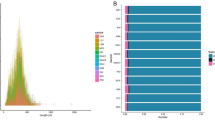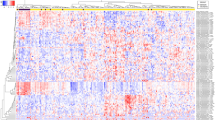Abstract
Prostate cancer (PCa) is the most frequent male malignancy and the second most common cause of cancer-related death in Western countries. Current clinical and pathological methods are limited in the prediction of postoperative outcome. It is becoming increasingly evident that small non-coding RNA (ncRNA) species are associated with the development and progression of this malignancy. To assess the diversity and abundance of small ncRNAs in PCa, we analyzed the composition of the entire small transcriptome by Illumina/Solexa deep sequencing. We further analyzed the microRNA (miRNA) expression signatures of 102 fresh-frozen patient samples during PCa progression by miRNA microarrays. Both platforms were cross-validated by quantitative reverse transcriptase–PCR. Besides the altered expression of several miRNAs, our deep sequencing analyses revealed strong differential expression of small nucleolar RNAs (snoRNAs) and transfer RNAs (tRNAs). From microarray analysis, we derived a miRNA diagnostic classifier that accurately distinguishes normal from cancer samples. Furthermore, we were able to construct a PCa prognostic predictor that independently forecasts postoperative outcome. Importantly, the majority of miRNAs included in the predictor also exhibit high sequence counts and concordant differential expression in Illumina PCa samples, supported by quantitative reverse transcriptase–PCR. Our findings provide miRNA expression signatures that may serve as an accurate tool for the diagnosis and prognosis of PCa.
This is a preview of subscription content, access via your institution
Access options
Subscribe to this journal
Receive 50 print issues and online access
$259.00 per year
only $5.18 per issue
Buy this article
- Purchase on Springer Link
- Instant access to full article PDF
Prices may be subject to local taxes which are calculated during checkout






Similar content being viewed by others
Accession codes
References
Ambs S, Prueitt RL, Yi M, Hudson RS, Howe TM, Petrocca F et al. (2008). Genomic profiling of microRNA and messenger RNA reveals deregulated microRNA expression in prostate cancer. Cancer Res 68: 6162–6170.
Berezikov E, Thuemmler F, van Laake LW, Kondova I, Bontrop R, Cuppen E et al. (2006). iversity of microRNAs in human and chimpanzee brain. Nat Genet 38: 1375–1377.
Bin Hafeez B, Adhami VM, Asim M, Siddiqui IA, Bhat KM, Zhong W et al. (2009). Targeted knockdown of Notch1 inhibits invasion of human prostate cancer cells concomitant with inhibition of matrix metalloproteinase-9 and urokinase plasminogen activator. Clin Cancer Res 15: 452–459.
Brameier M, Herwig A, Reinhardt R, Walter L, Gruber J . (2011). Human box C/D snoRNAs with miRNA like functions: expanding the range of regulatory RNAs. Nucleic Acids Res 39: 675–686.
Care A, Catalucci D, Felicetti F, Bonci D, Addario A, Gallo P et al. (2007). MicroRNA-133 controls cardiac hypertrophy. Nat Med 13: 613–618.
Catto JW, Alcaraz A, Bjartell AS, De Vere White R, Evans CP, Fussel S et al. (2011). MicroRNA in prostate, bladder, and kidney cancer: a systematic review. Eur Urol 59: 671–681.
Chiosea S, Jelezcova E, Chandran U, Acquafondata M, McHale T, Sobol RW et al. (2006). Up-regulation of dicer, a component of the microRNA machinery, in prostate adenocarcinoma. Am J Pathol 169: 1812–1820.
Coppola V, De Maria R, Bonci D . (2010). MicroRNAs and prostate cancer. Endocr Relat Cancer 17: F1–17.
Datta J, Kutay H, Nasser MW, Nuovo GJ, Wang B, Majumder S et al. (2008). Methylation mediated silencing of microRNA-1 gene and its role in hepatocellular carcinogenesis. Cancer Res 68: 5049–5058.
Dong X-Y, Rodriguez C, Guo P, Sun X, Talbot JT, Zhou W et al. (2008). SnoRNA U50 is a candidate tumor-suppressor gene at 6q14.3 with a mutation associated with clinically significant prostate cancer. Hum Mol Genet 17: 1031 .
Ender C, Krek A, Friedländer MR, Beitzinger M, Weinmann L, Chen W et al. (2008). A human snoRNA with microRNA-like functions. Mol Cell 32: 519–528.
Ferlay J, Autier P, Boniol M, Heanue M, Colombet M, Boyle P . (2007). Estimates of the cancer incidence and mortality in Europe in 2006. Ann Oncol 18: 581–592.
Gandellini P, Folini M, Longoni N, Pennati M, Binda M, Colecchia M et al. (2009). miR-205 exerts tumor-suppressive functions in human prostate through down-regulation of protein kinase Cepsilon. Cancer Res 69: 2287–2295.
Gillies JK, Lorimer IAJ . (2007). Regulation of p27Kip1 by miRNA 221/222 in glioblastoma. Cell Cycle 6: 2005–2009.
Git A, Dvinge H, Salmon-Divon M, Osborne M, Kutter C, Hadfield J et al. (2010). Systematic comparison of microarray profiling, real-time PCR, and next-generation sequencing technologies for measuring differential microRNA expression. RNA 16: 991–1006.
Ke XS, Qu Y, Rostad K, Li WC, Lin B, Halvorsen OJ et al. (2009). Genome-wide profiling of histone h3 lysine 4 and lysine 27 trimethylation reveals an epigenetic signature in prostate carcinogenesis. PLoS One 4: e4687.
Kishore S, Stamm S . (2006). The snoRNA HBII-52 regulates alternative splicing of the serotonin receptor 2C. Science 311: 230–232.
Lee JT, Lehmann BD, Terrian DM, Chappell WH, Stivala F, Libra M et al. (2008). Targeting prostate cancer based on signal transduction and cell cycle pathways. Cell Cycle 15: 1745–1762.
Lu J, Getz G, Miska EA, Alvarez-Saavedra E, Lamb J, Peck D et al. (2005). MicroRNA expression profiles classify human cancers. Nature 435: 834–838.
Majid S, Dar AA, Saini S, Yamamura S, Hirata H, Tanaka Y et al. (2010). MicroRNA-205-directed transcriptional activation of tumor suppressor genes in prostate cancer. Cancer 116: 5637–5649.
Marberger M . (2009). Prostate cancer 2008: challenges in diagnosis and management. Eur Urol, Supplements 8: 89–96.
Marshall L, White RJ . (2008). Non-coding RNA production by RNA polymerase III is implicated in cancer. Nat Rev Cancer 8: 911–914.
Mattick JS, Makunin IV . (2006). Non-coding RNA. Hum Mol Genet 15 (Spec No 1): R17–R29.
Michael MZ, SM OC, van Holst Pellekaan NG, Young GP, James RJ . (2003). Reduced accumulation of specific microRNAs in colorectal neoplasia. Mol Cancer Res 1: 882–891.
Morin RD, O'Connor MD, Griffith M, Kuchenbauer F, Delaney A, Prabhu AL et al. (2008). Application of massively parallel sequencing to microRNA profiling and discovery in human embryonic stem cells. Genome Res 18: 610–621.
Mukherjee R, McGuinness DH, McCall P, Underwood MA, Seywright M, Orange C et al. (2011). Upregulation of MAPK pathway is associated with survival in castrate-resistant prostate cancer. Br J Cancer 104: 1920–1928.
Ozen M, Creighton CJ, Ozdemir M, Ittmann M . (2008). Widespread deregulation of microRNA expression in human prostate cancer. Oncogene 27: 1788–1793.
Paronetto MP, Farini D, Sammarco I, Maturo G, Vespasiani G, Geremia R et al. (2004). Expression of a truncated form of the c-Kit tyrosine kinase receptor and activation of Src kinase in human prostatic cancer. Am J Pathol 164: 1243–1251.
Porkka KP, Pfeiffer MJ, Waltering KK, Vessella RL, Tammela TLJ, Visakorpi T . (2007). MicroRNA expression profiling in prostate cancer. Cancer Res 67: 6130–6135.
Prueitt RL, Yi M, Hudson RS, Wallace TA, Howe TM, Yfantis HG et al. (2008). Expression of microRNAs and protein-coding genes associated with perineural invasion in prostate cancer. Prostate 68: 1152–1164.
Radmacher MD, McShane LM, Simon R . (2002). A paradigm for class prediction using gene expression profiles. J Comput Biol 9: 505–511.
Reis EM, Nakaya HI, Louro R, Canavez FC, Flatschart AV, Almeida GT et al. (2004). Antisense intronic non-coding RNA levels correlate to the degree of tumor differentiation in prostate cancer. Oncogene 23: 6684–6692.
Ribas J, Ni X, Haffner M, Wentzel EA, Salmasi AH, Chowdhury WH et al. (2009). miR-21: an androgen receptor-regulated microRNA that promotes hormone-dependent and hormone-independent prostate cancer growth. Cancer Res 69: 7165–7169.
Royo H, Bortolin ML, Seitz H, Cavaillé J . (2006). Small non-coding RNAs and genomic imprinting. Cytogenet and Genome Res 113: 99–108.
Schaefer A, Jung M, Mollenkopf H-J, Wagner I, Stephan C, Jentzmik F et al. (2010). Diagnostic and prognostic implications of microRNA profiling in prostate carcinoma. Int J Cancer 126: 1166–1176.
Shi X-B, Xue L, Yang J, Ma A-H, Zhao J, Xu M et al. (2007). An androgen-regulated miRNA suppresses Bak1 expression and induces androgen-independent growth of prostate cancer cells. Proc Natl Acad Sci USA 104: 19983–19988.
Simon R, Radmacher MD, Dobbin K, McShane LM . (2003). Pitfalls in the use of DNA microarray data for diagnostic and prognostic classification. J Natl Cancer Inst 95: 14–18.
Spahn M, Kneitz S, Scholz CJ, Stenger N, Rudiger T, Strobel P et al. (2010). Expression of microRNA-221 is progressively reduced in aggressive prostate cancer and metastasis and predicts clinical recurrence. Int J Cancer 127: 394–403.
Sun T, Wang Q, Balk S, Brown M, Lee GS, Kantoff P . (2009). The role of microRNA-221 and microRNA-222 in androgen-independent prostate cancer cell lines. Cancer Res 69: 3356–3363.
Szczyrba J, Loprich E, Wach S, Jung V, Unteregger G, Barth S et al. (2010). The microRNA profile of prostate carcinoma obtained by deep sequencing. Mol Cancer Res 8: 529–538.
Taft RJ, Glazov EA, Lassmann T, Hayashizaki Y, Carninci P, and Mattick JS et al. (2009). Small RNAs derived from snoRNAs. RNA 15: 1233–1240.
Tong AW, Fulgham P, Jay C, Chen P, Khalil I, Liu S et al. (2009). MicroRNA profile analysis of human prostate cancers. Cancer Gene Ther 16: 206–216.
Volinia S, Calin GA, Liu C-G, Ambs S, Cimmino A, Petrocca F et al. (2006). A microRNA expression signature of human solid tumors defines cancer gene targets. Proc Natl Acad Sci USA 103: 2257–2261.
Waltering KK, Porkka KP, Jalava SE, Urbanucci A, Kohonen PJ, Latonen LM et al. (2011). Androgen regulation of micro-RNAs in prostate cancer. Prostate 71 (6): 604–614.
Wang S, Bian C, Yang Z, Bo Y, Li J, Zeng L et al. (2009). miR-145 inhibits breast cancer cell growth through RTKN. Int J Oncol 34: 1461–1466.
Wiklund ED, Bramsen JB, Hulf T, Dyrskjot L, Ramanathan R, Hansen TB et al. (2010). Coordinated epigenetic repression of the miR-200 family and miR-205 in invasive bladder cancer. Int J Cancer 128: 1327–1334.
Willenbrock H, Salomon J, Sokilde R, Barken KB, Hansen TN, Nielsen FC et al. (2009). Quantitative miRNA expression analysis: comparing microarrays with next-generation sequencing. RNA 15: 2028–2034.
Wit E, Linsen SEV, Cuppen E, Berezikov E . (2009). Repertoire and evolution of miRNA genes in four divergent nematode species. Genome Res 19: 2064–2074.
Wright GW, Simon RM . (2003). A random variance model for detection of differential gene expression in small microarray experiments. Bioinformatics 19: 2448–2455.
Zhao J-J, Lin J, Yang H, Kong W, He L, Ma X et al. (2008). MicroRNA-221/222 negatively regulates estrogen receptor{alpha} and is associated with tamoxifen resistance in breast cancer. J Biol Chem 283: 31079–31086.
Acknowledgements
We thank Theo van der Kwast for histo-pathological examination of patient samples. We also thank Mark Wildhagen for providing the coded clinical data. We acknowledge the European Community's Seventh Framework Program (FP7/2007-2013), grant agreement No HEALTH-F2-2007-201438, the Academy of Finland; Cancer Society of Finland; Reino Lahtikari Foundation; Sigrid Juselius Foundation; and the Medical Research Fund of Tampere University Hospital for their support.
Author information
Authors and Affiliations
Corresponding author
Ethics declarations
Competing interests
Dr Litman and Dr Møller have been employed by Exiqon A/S and own stocks in that company. The remaining authors declare no conflict of interest.
Additional information
Supplementary Information accompanies the paper on the Oncogene website
Rights and permissions
About this article
Cite this article
Martens-Uzunova, E., Jalava, S., Dits, N. et al. Diagnostic and prognostic signatures from the small non-coding RNA transcriptome in prostate cancer. Oncogene 31, 978–991 (2012). https://doi.org/10.1038/onc.2011.304
Received:
Revised:
Accepted:
Published:
Issue Date:
DOI: https://doi.org/10.1038/onc.2011.304
Keywords
This article is cited by
-
Expression profiles of small non-coding RNAs in breast cancer tumors characterize clinicopathological features and show prognostic and predictive potential
Scientific Reports (2022)
-
miR-32 promotes MYC-driven prostate cancer
Oncogenesis (2022)
-
Gly-tRF enhances LCSC-like properties and promotes HCC cells migration by targeting NDFIP2
Cancer Cell International (2021)
-
The tRNA-derived fragment 5026a inhibits the proliferation of gastric cancer cells by regulating the PTEN/PI3K/AKT signaling pathway
Stem Cell Research & Therapy (2021)
-
tRNA-derived small RNAs: novel regulators of cancer hallmarks and targets of clinical application
Cell Death Discovery (2021)



